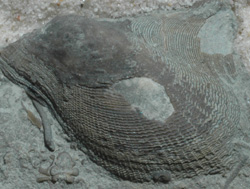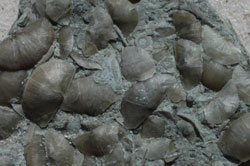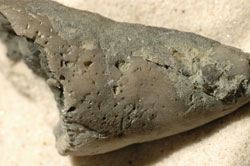Should Fragile Shells Be Common in the Fossil Record? by John Whitmore
Have you ever walked along the beach collecting
shells? Usually the best ones are thick and durable. Rarely do you find delicate
shells in pristine condition.
In modern oceans, shells gradually dissolve in sea water or are consumed by
other organisms. Experiments have shown that many shells, especially thin and
fragile ones, disappear completely in a short period of time.
If the fossil record formed slowly, with individual rock layers taking
hundreds or thousands of years to accumulate, you would expect fragile shell
material to be relatively uncommon. Most of what we find should be thick and
durable.
Creationists, on the other hand, would expect to find good preservation of
all types of animals in the fossil record because we believe much of the record
was made catastrophically during Noah’s Flood.
Let’s see what is actually found.
Studies in Modern Oceans
Taphonomy is the study of the process of decay and fossilization.
Taphonomists have extensively studied the disintegration of shelly remains. They
have run many experiments on crabs, snails, clams, and other animals with hard
shells in modern underwater settings.1,2
As expected, the soft tissue is usually gone within days. Surprisingly, the
hard shelly material can also be destroyed soon afterward (days to years) by a
number of processes, including the dissolving action of seawater, gnawing,
boring, currents, and animals churning through the ocean mud in search of
nutrients.3,4
Problems and Surprises

This ornamented fossil clam had to be buried quickly in
order for its delicate details to be preserved. In modern oceans, thin,
fragile shells like this are destroyed quickly. Most shell material
preserved in modern oceans is thick, because thin shell material can be
quickly destroyed. However, new studies show the fossil record is not biased
toward thick-shelled organisms. This is evidence that most of the fossil
record formed catastrophically.

Mass accumulations of thin-shelled brachiopods are common
in the fossil record. Even conventional geologists agree that deposits like
this were made rapidly during storm events. It is common for thin shells in
today’s oceans to be completely destroyed by boring and encrusting
organisms.

This fossil horn coral, found in the Flood deposits near
Cincinnati, Ohio, had been bored and encrusted by various organisms prior to
its burial. Organisms bore for food, nutrients, or domiciles. Encrusters,
like the bryozoans (along the top edge of the coral), use the coral’s hard
surface as a foundation for their colony.
Rapid decay of hard shelly material in modern oceans has created a paradox
for old-age, uniformitarian thinking. Taphonomist Thomas Olszewski is puzzled by
the apparent discrepancy between modern studies and the fossil record:
Actualistic studies show that taphonomic destruction of the remains of
shelly marine organisms can be completed on the order of days to years. Yet,
radiometric and amino-acid age dating show that shells in settings where
taphonomic destruction is ongoing can be 10s, 100s, or even 1000s of years
old. In order to resolve this seeming paradox, a number of authors have
suggested that shells survive to great age by being sequestered temporarily
from taphonomically destructive conditions and then reintroduced to the
taphonomically active zone (that part of the sediment column in which a
fossil can be modified or destroyed) by sedimentary mixing processes.4
Note the suggestion that shells must be “sequestered” from decay for many
years in order to resolve the paradox between belief in old age and the observed
rapid rate of shell disintegration. What Olszewski is proposing is that shell
material must, upon death, be buried deep in ocean mud if it has any hope of
preservation. This is the only way to protect the material from destruction.
The real paradox for the old-age uniformitarian is that ocean mud is not
accumulating fast enough for preservation to occur; so why does the fossil
record have shelly material at all, if it has taken long periods of time to
accumulate?
An additional and more serious problem has surfaced for old-age
uniformitarianism.5
Even though small, fragile, thin-shelled animals disappear rapidly in modern
settings, a recent study found that small, fragile, thin-shelled fossils are as
likely to be present in the fossil record as large, durable, thick-shelled
fossils.
Using the online Paleobiology Database (PBDB), scientists compared 150 of the
most common genera of marine shellfish and snails (brachiopods, bivalves, and
gastropods) with each other (450 total genera). The authors conclude:
Contrary to taphonomic expectation, common genera in the PBDB are as likely
to be small, thin-shelled, ribbed, folded, or spiny. In fact, only six of
the 30 tests we performed showed a statistically significant relationship
between durability and occurrence frequency, and these six tests were
equally divided in supporting or contradicting the taphonomic expectation.
The authors were surprised and confounded by the results because modern
observations did not match their expectations. They concluded that the fossil
record was not biased towards more durable shelly material.
One explanation that they did not consider, that would readily explain their
results, is the catastrophic formation of much of the fossil record. The Flood
would have indiscriminately buried both fragile and durable material together.
Conclusion
Creationists have correctly argued for a long time that preservation of soft
body parts requires special conditions or even catastrophic processes. Now we
can make the same argument for many of the hard parts found in the fossil
record.
Dr. John Whitmore earned his doctorate in
biology with a paleontology emphasis from Loma Linda University. He is now
associate professor of geology at Cedarville University. Dr. Whitmore has
written numerous articles and co-authored
The Great Alaskan
Dinosaur Adventure
http://www.answersingenesis.org/articles/am/v2/n2/fragile-shells-fossil-record


